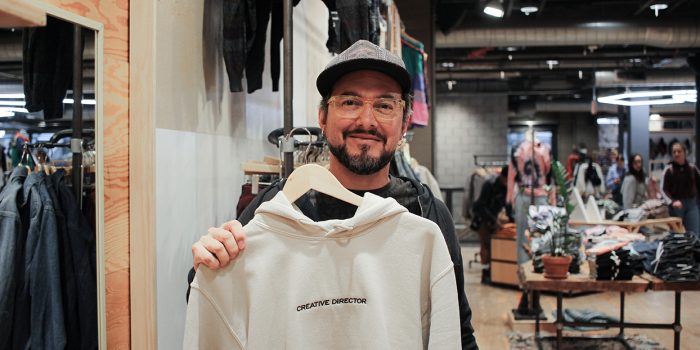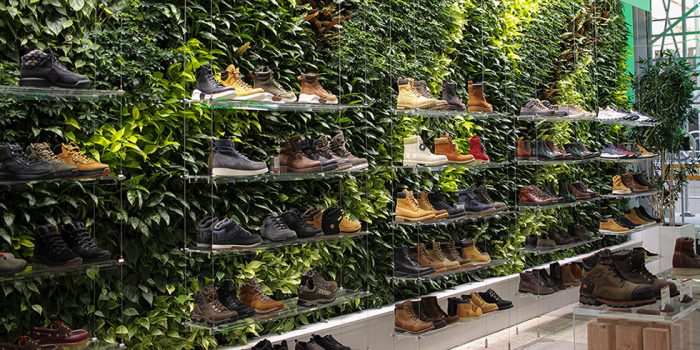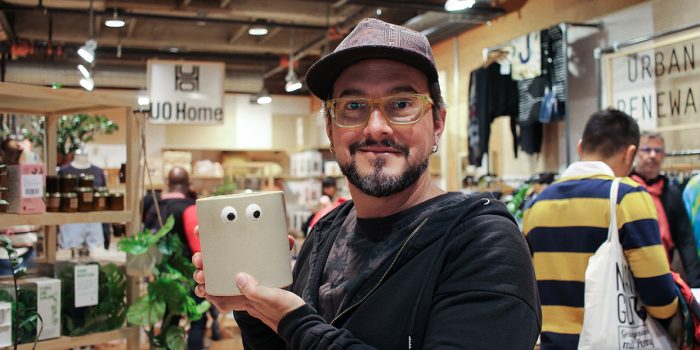
Do you remember the last time you went a day without going online? Nowadays, everyone is perpetually connected to the internet through smaller and more personalized devices. This new way of life has also largely changed the way people consume and purchase things. Bloomberg recently reported that online stores have gained the second biggest share of the U.S. retail market, surpassing grocery stores and restaurants. With the rise of E-Commerce, many feared that physical retail stores would disappear. Yet, in an increasingly digital world, brands have the chance to make use of people’s craving for physical experiences to prevent the so-called retail apocalypse.
OSK’s Creative Director Scott Faucheux has almost two decades’ worth of retail design experience for clients such as Samsung, Urban Outfitters and Kiehls. Alum of Virginia Tech’s School of Architecture and Urban Studies, he calls himself a designer and brand thinker who creates innovative combinations of brands, people and places to turn them into compelling experiences. Over the course of his career, he gradually evolved into the world of experience design and has been refining and redefining the role of experiences in the built environment.

Scott, you have been working on retail design projects for the last twenty years. Recently, an increasing number of retail stores are closing, which many attribute to the rising dominance of online shopping. Looking back, how would you say retail has changed over time and how is it adapting to the digitalization of life?
One of the biggest conversations right now is around the retail apocalypse. Why are all these brands failing? I like to think of the main factors as the four horsemen: Bad product, bad service, bad spaces and most importantly bad stories. There is an evolved sophistication that is happening and technology really has enabled it. More and more retailers are using data to understand what people are doing, which is kind of a paradox. Twenty years ago, if you said data is going to run the stores, people would freak out and say “Oh my god we’re all going to turn into robot people!” But the reality is that technology is enhancing personalization and understanding of how people shop, and also how a particular person shops. We can actually track and personalize experiences and build around an individual, which is a pretty fantastic change from just putting a commodity on a shelf and promoting it. Instead, we can build a story and create emotions around a product.
You have to reconsider what the purpose of the store is. In the past, the store has always been the transaction point and that is not true anymore.
“Experiential” has been one of the key words for a while now. How does that specifically affect retail design?
You have to reconsider what the purpose of the store is. In the past, the store has always been the transaction point and that is not true anymore. If we think about a store as a mere commodities point, it represents a very a different value than if we consider it as a communications point or as a brandscape to tell a story. Brands now are telling their stories in stores through sensory experiences that are multi-dimensional. Some incredibly rich and layered things are happening in new stores right now because the focus is not around the product anymore. Stores are taking consumers on journeys and telling them focused and curated messages that they can take on and add meaning to. People are no longer shopping for mere objects, but are finding cultural artifacts. Stores now have much more power as a story-telling platform than they do as a transactional platform.

What other societal trends are affecting consumer behaviors? How do you translate those into store design?
I think there are a couple societal shifts that have radically altered the way we think about communities in general as well as brand communities. One is the level of social sharing and the level of reach that each individual has into their network. The other is their ability to share their own ideas. It is really amazing to see brands which embrace that and invite their audiences to actually co-author an experience with them. What in the past may have been a brand just saying “Here is what we are, you take that message,” now, is a conversation around “Here is what we have to offer, what do you think?” This way, you can change opinions and create a much broader, more meaningful and relevant idea about what a brand is and what it means to a larger audience.
Are shareable experiences and moments the key to retail success?
There are definitely brands that are simply manufacturing moments that are meant for sharing, and I would say with a wide variety of success. The authenticity with which you create an experience should be natural and not forced. You see a lot of cool pop-ups with things like Instagram walls – that is manufacturing a moment to be shared in a very specific way. Instead, you should rather create environments where people can explore and find their own moment that they share because they want to and not because the brand says “Here is the format, go share it.”
Now, retail design is only one small portion of the design work that you do. Can you apply your experience from the retail world to other areas of your work?
The approach I use for my design work is one of really looking empathetically at what the visitor journey should be: What happens along the way? Where are the actions and where are the emotions that need to happen? All of those little cues and moments that make up a journey can be scripted not just in a retail environment but in hospitality and events as well. If we remove the words retail, event or pop-up from the discussion and completely do away with the labels that set boundaries around our work, and begin to think about it just in terms of the visitor’s journey, we can improve all experiences because we are no longer constrained by what we think needs to be. If we eliminate the automatic programing, there is a lot more opportunity to create more impactful and compelling experiences. We can actually innovate by looking at other formats and creating the right impact, the right sensory cues, the right drama.

How does the future of retail look like? And are there examples of brands that are already offering those experiences today?
I think there are three main divergent paths for what the future retail experience will look like. The easy answer is of course big technology with seamless interactions and all kinds of user-generated elements. Those immersive theaters of amazing technology are easily predictable. At the opposite end of that spectrum are brands like Urban Outfitters and Anthropology that are art-driven, completely unique and that are very tactile and sensual. You explore and discover that no two stores are alike and it is up to you to come and find what is cool and what works for you. I think it is that level of personal discovery that is really going to drive the future of retail – whether it is technology-aided or anti-tech. Those possibilities exist anywhere along that spectrum.
The third one that is also really fascinating is demonstrated by Intersect by Lexus here in New York: a brand world that is not necessarily about your product. It is about attention to detail, the appreciation of craft, and what you and your brand really stand for – all coming to life through a whole series of experiences that touch different parts of what we are interested in as people. I think those brandscapes coming to life have huge potential for the future and are something that we are going to see a lot more of.
What do you think will be the next big thing in retail?
I think the next big thing in retail is going to be human-centered design. We have to keep in mind that because the POS can be anywhere, the store itself becomes a story-telling environment and the level of service that you get along the journey is way more important – that really is becoming the transaction rather than the actual exchange of money for goods and services. Retailers who are not investing in understanding how to speak more meaningfully to customers are limiting themselves and no one is going to come to their stores because there is no value. Looking at how our understanding of a person, the data we collect around that person, and how that data creates tailored experiences is really going to be transformative in shaping the future retail experience.







